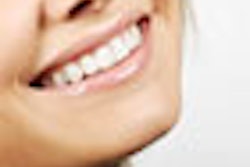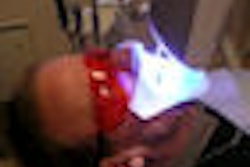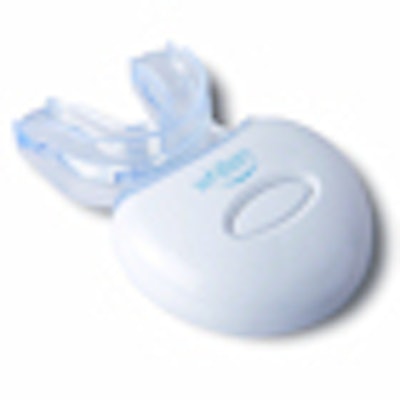
A patented, hands-free system that combines a blue light-emitting diode (LED) device with a proprietary mouthpiece and a specially formulated gel is one of the latest additions to the booming at-home teeth-whitening market.
Kaya Bromley, one of the inventors of the Whiten personal teeth-whitening system, is quick to give her father credit for the product inspiration that came to her six years ago.
"My dad was a successful dental equipment supplier," Bromley said. "One day he told me that the same LED whitening systems his dentist clients used were also being ordered by salons and spas."
That got her wheels turning. "I thought, hey, if the process doesn't require a dentist, maybe there is a way to make it convenient and affordable for everyone."
Bromley, along with some partners, started to sell the lights to spas and salons and had quite a bit of business success. During a four-year period, she and her partners visited manufacturers in the U.S. to really understand the technology.
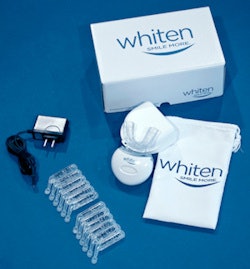 The Whiten personal teeth-whitening system. All images courtesy of Whiten.
The Whiten personal teeth-whitening system. All images courtesy of Whiten.
"An LED light-based whitening procedure costs anything from $300 to $700 in the dental office," Bromley said. "From what we learned and saw, it did not need to cost this much."
Joe Dwyer, current head of sales at Whiten and also a co-inventor, has been on this journey with Bromley from the beginning. Another partner is Valtec, a Michigan-based company that does plastic injection molding for the automobile industry and now manufactures the Whiten system. Valtec is owned by Joe Winget, Nick DeMiro, Joe Tignanelli, and Pete Salpietra.
"This group is interesting because they are actually automotive suppliers but took on this project because it interested them," Bromley said.
Wavelength critical
The Whiten team used the professional dental lights as a baseline to make sure their light was the same quality and strength, and set out to create a compact product.
The development process took a year and a half, and the Whiten teeth-whitening system was launched in July of this year. The system includes a luminator base, a USB charger, a mouthpiece with case, 12 single-treatment gel tubes, and a travel bag.
“The strength of our product is our light and mouthpiece.”
After securing the mouthpiece to the luminator base, a single treatment tube of gel is squeezed evenly into the top and bottom groves of the mouthpiece. The user then bites down gently, pushes the on button, and leaves it in the mouth for 10 minutes. The mouthpiece is designed to channel blue LED light evenly across the surface of the teeth.
The company recommends three to five treatments for the first week, depending on the individual situation followed by a regular touch-up as needed.
A unique feature of the product is that the mouthpiece holds the gel directly against the teeth, something that makes whitening procedures in the dental office so effective, Bromley explained.
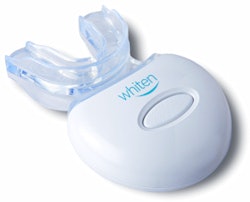 The Whiten light.
The Whiten light.
"Most at-home systems don't do that, or don't do that very effectively," she said.
Clinical studies have found that the light has to be of a certain intensity -- generally in the 450-500 nanometer range -- for the whitening to be effective, she added. The Whiten system utilizes an LED light with a wavelength of 475 nm.
"When whitening got really big, people came out with a lot of light-based whitening systems, but they did not make sure that the light was the right wavelength or intensity," Bromley said. "My guess is that if a light-based whitening system is being sold for $15 or $20, there is no way they are using the wavelength or intensity that is needed for optimum results."
The gel used in their product contains 22% carbamide peroxide and comes strictly from U.S. vendors.
"A lot of other products are using gels that are not produced in the U.S., and the quality control can come under question," she said.
Focus groups
The company did not conduct its own clinical trials because they repackaged existing technology and clinical studies had already been done on the effectiveness of that technology, Bromley noted.
Instead the company conducted focus groups asking participants about the product's website (appearances, ease of use, content), packaging (appearance, presentation, branding), the product itself (appearance, functionality, assembly), and pricing. They found that most people had favorable opinions.
The complete Whiten kit retails for $199. One household can share a single luminator and buy multiple mouthpieces, which are interchangeable. An extra mouthpiece and gel set can be purchased for $59.95 and includes one mouthpiece with case and 12 single-treatment gel tubes.
The Whiten system can currently be ordered from the company website, as well as on Amazon.com, and is also available at certain salons, spas, and dental offices. The company is also in talks with retailers.
"The strength of our product is our light and mouthpiece," Bromley concluded. "We have received numerous requests from dentists who want to sell it in their practice."




